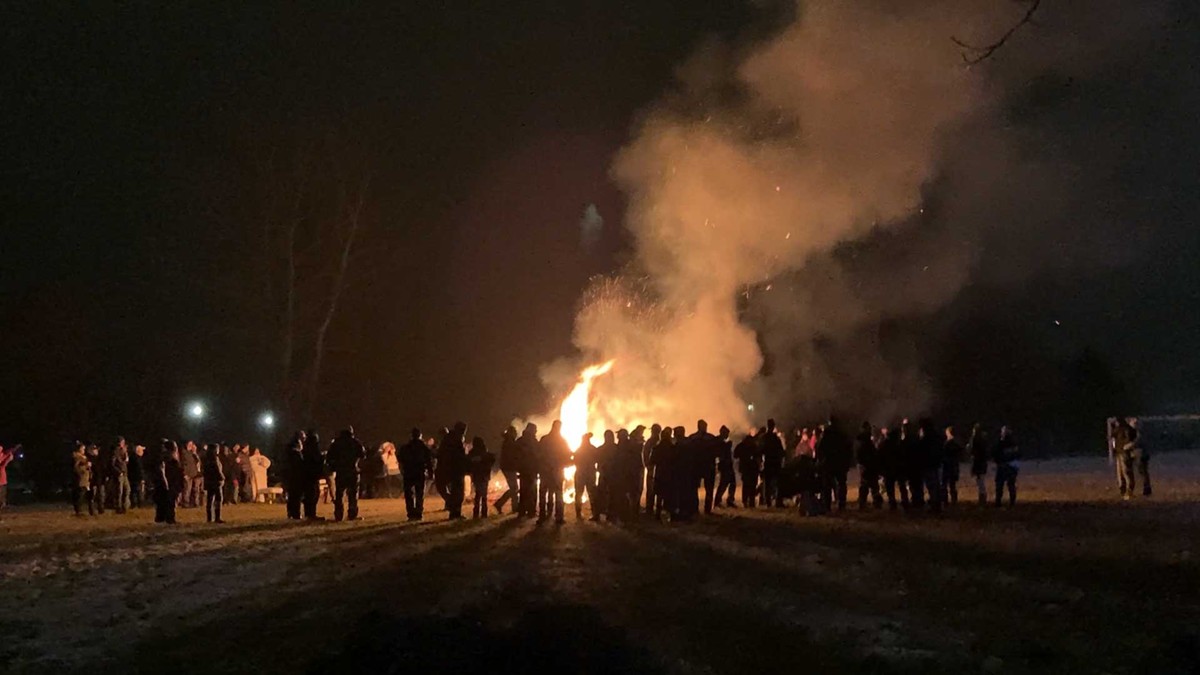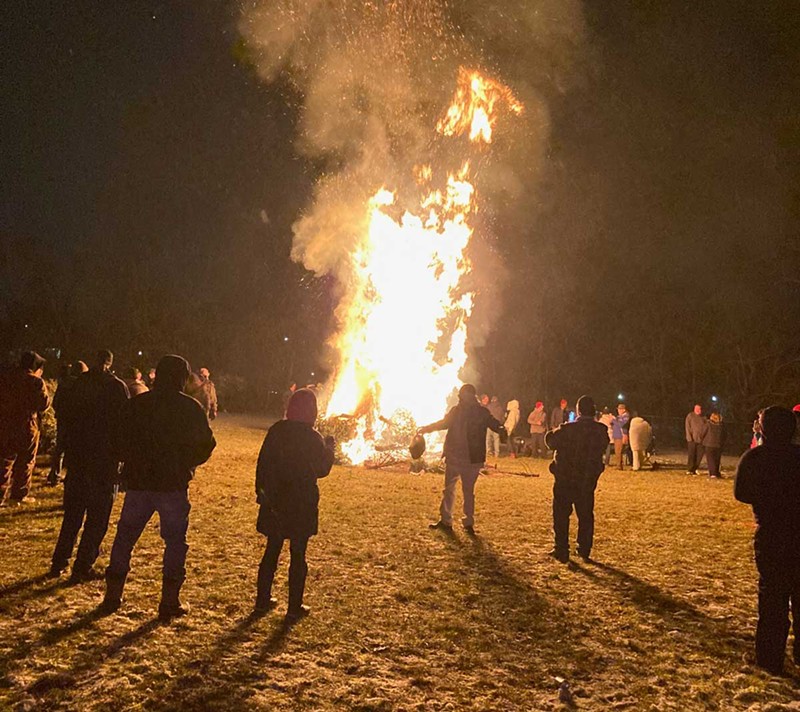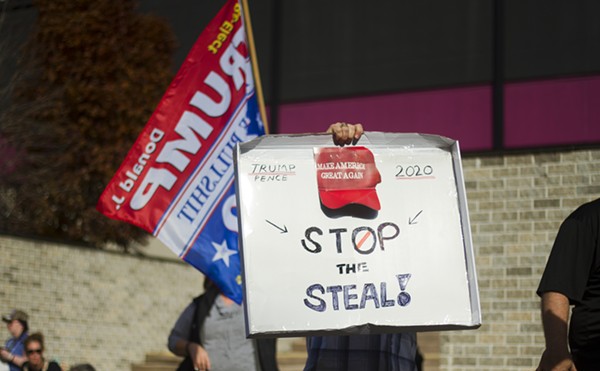Just before Christmas, the St. Martin neighborhood reunion committee met to plan this September’s picnic event. One member joked: “Are we going to have the Christmas tree burning this year?”
That flashback referred to the 1960s and what was then known as Hansen Field, across the street from St. Martin of Tours church and school at Avondale and Drexel on Detroit’s East Side.
Of course, we Cadet senior citizens reminisced fondly about trails of dry, green pine needles left in the snow from every alley in the Jefferson-Chalmers neighborhood as we pretended back then that the cops and firefighters who lived there didn’t have a clue as to what we were up to every year at the same time.
We joked back then that our blaze was so big that astronauts like John Glenn could’ve seen it from outer space. And we wondered: When did that peculiar annual tradition begin? When did it end? Who started it? And did anyone try to continue it?
As it turns out the ritual got revived, risen like a phoenix from the ashes in “probably the mid-1990s,” according to Robert Pickard, 69, a lifetime Jefferson-Chalmers resident who now organizes the collection and burning of hundreds of trees. “We’ve done it for probably about 30 years.”
The original fires burned on the softball field across the street from the now-abandoned church, the vanished convent, and the empty lot of the torn-down school.
But the current Jeff-Chal blaze burns on the soccer field at Mariner Park, a small patch of grass in the extreme southeast corner of the city, on the shore where the Detroit River merges with Lake St. Clair, just a couple hundred yards (or meters) from Canada’s Peche Island.
The park — once the site of the demolished Marine Hospital — provided the venue for the origin story of Pickard’s tradition.
“I was down here one night with a friend and we burned a joint,” he said. “It was cold. So we burned a tree.”
His inspiration came from his 1960s youth, Pickard said, when he attended the blazes at St. Martin, walking from his home on Marlborough, where he still lives. The Mariner site sits about one mile southeast of St. Martin, bordered by several boat canals.
This year’s blaze came last Saturday. Being early winter, it occurred during one of the longest nights of the year.
Starting at 5 p.m., Pickard directed a parade of vans, rented trucks, trailers, and cars that schlepped probably 300 trees to be ignited at 9 p.m. across a canal from what used to be called Angel Park, just down the shore from what used to be called Lakewood Park.
Pickard said Jefferson-Chalmers doesn’t have as many Christmas trees (or people) as it used to, so his crew scouts for them mostly on curbs in the Grosse Pointes and other East Side suburbs. One year, he said, a Border Patrol cop followed him home to ask about all the dead trees in his backyard.
Channel 4, Pickard said, once did an investigation of him for “illegal dumping,” although he said he explained to reporter Karen Drew that it was just temporary and not to worry. Fresh Christmas trees, Pickard added, now cost around $100.
“So if we’ve got 300 trees,” he said last weekend, “that’s about $30,000 worth, right?”
By lighting time — four hours after sundown on a gray and gloomy day — about 100 cars filled a parking lane and about 250 persons gathered in a wide circle.
One man shot fireworks overhead and another blasted classic rock music from a portable stereo as they tried to set the night on fire. Snow flurries fell under a light breeze, swirling and twinkling through the bright bulbs of the park’s lights.
Loud cheers erupted whenever a big evergreen landed on top of a 15-foot pile and then exploded with first a little hiss and then a big whoosh. Some of the revelers drank beverages and smoked cigarettes while sitting in lawn chairs on a thin covering of light snow, which melted to muddy slush near the fire.
After about 20 minutes of high flames, a red fire truck could be seen in the distance, crossing a little bridge at the foot of Alter Road. Although its lights flashed, no bell or siren sounded. The firefighters parked, observed for a few minutes at a distance, then left.
A few minutes later — again with flashers but no sirens — three Detroit police cars entered the park, idled by the curb for a few minutes, then left.
A first-time visitor couldn’t help but get the feeling that these were routine runs, although Pickard said he got some grief from civic authorities a few years back when he threw his mother’s sofa into the conflagration and a former firefighter from the ‘hood sat on it in full regalia.
One of Pickard’s aides said a freighter ship a few years back cruised by the shore, saw the big bonfire, and turned a big, bright searchlight on the gathering. Discovering it was a festive occasion, the freighter horn blew them a salute.
Pickard said he worked 17 years at Cobo Hall and Joe Louis Arena, as they were then known, setting up displays and shows. He is still active as a handyman on the East Side. On Saturday, he bossed a crew of about a dozen.
He instructed partiers in safety (no gasoline; no auxiliary fires) and proper assembly of the pile. Pickard must have thrown at least 100 trees onto the pile by himself. But the fireworks guy seemed unsupervised, and that suggested Detroit’s long relationship with smoke and fire, for both good and bad.
For instance: Around every Fourth of July and for other holidays to a lesser extent, we buy more fireworks than most people and we leave many neighborhoods shrouded in acrid smoke. Not everyone does this everywhere.
When the Tigers won their last World Series championship in 1984, the enduring image lingering from that celebration was of fans dancing in front of a burning police car. And that’s how we acted while in a good mood.
For more than a decade — thank goodness not so much anymore — every “Devil’s Night” saw arsonists torch vacant buildings around the Motor City on the evening before Halloween. Before that, the 1967 riot and rebellion left such images aflame in the national psyche.
Hell, even our city motto fights fire with faith.
“Speramus Meliora Resurget Cineribus,” it says, which is Latin for “We hope for better things; it shall rise from the ashes.” That was written in 1805 after a blaze destroyed Detroit when it was a frontier town and before Michigan was a state. It was written by Father Gabriel Richard.
Perhaps his spirit may bless our St. Martin reunion, to be held in the daylight hours of Saturday, September 7. For information, consult the St. Martin Neighborhood Reunion website on Facebook or send an email to [email protected].
Although that gathering also will be held at a waterfront park, the organizers assure the public that no trees, living or dead, will be harmed in this event.
@metrotimes #detroit #eastsidedetroit #jeffersonchalmers #metrodetroit ♬ original sound - Detroit Metro Times
Subscribe to Metro Times newsletters.
Follow us: Google News | NewsBreak | Reddit | Instagram | Facebook | Twitter








